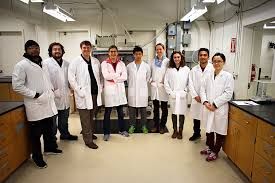Using silica gel to desalinate brackish water
Published on by Trudi Schifter, CEO and Founder AquaSPE in Business
Former UW lecturer and chemical engineering graduate student Greg Newbloom and mentor John Plaza developed technology using silica gel to desalinate brackish water. Newbloom and Plaza are now using that technology to power a new startup, Membrion, which aims to increase the ability for water purification at a lower cost.
 Silica gel is often found in small packets at the bottom of electronics, shoe boxes, and beef jerky. It has small pores on its surface that can absorb between 30-50% of its weight before it is saturated. Using membranes made of this material and applying electricity separates certain molecules for desalinated water.
Silica gel is often found in small packets at the bottom of electronics, shoe boxes, and beef jerky. It has small pores on its surface that can absorb between 30-50% of its weight before it is saturated. Using membranes made of this material and applying electricity separates certain molecules for desalinated water.
“While most of the other industry uses polymers from hydrocarbons, we use silica gel,” Plaza said. “We accomplish the same thing a polymer membrane does, but the components we use are 10 times cheaper and therefore gives us a lot more flexibility.”
This technology is focused on desalinating brackish water which is water that has too much salt for consumption, but not quite enough to be considered seawater.
By adjusting the pore size on the surface of the silica gel material, different types of particles can be filtered including salts, metals, and various protons.
While this technology can have many applications including energy, pharmaceuticals, and food production, Membrion is focused on the market for water desalination.
 Newbloom received an honor for entrepreneurial excellence from the UW College of Engineering. Along with his other projects for resource conservation, it is estimated that by 2025 these technologies would have helped save 480 billion gallons of water and 1 million tons of carbon dioxide.
Newbloom received an honor for entrepreneurial excellence from the UW College of Engineering. Along with his other projects for resource conservation, it is estimated that by 2025 these technologies would have helped save 480 billion gallons of water and 1 million tons of carbon dioxide.
According to a press release by Membrion in early March, the company has raised $6 million to commercialize the new technology.
In the coming year, Membrion plans to increase commercial volume, the scale of manufacturing, team size, and facility size to meet customer demands in the desalination market. They also plan to build pipelines of additional market opportunities that would allow them to expand.
“Our success is really based on the culture of innovation and support that the university gave Greg [Newbloom] at the beginning,” Plaza said. “Because without that help we wouldn’t exist today. We are always thrilled to be highlighted as an example of the types of exciting technologies that come out of universities.”
Media
Taxonomy
- Membranes
- Membrane